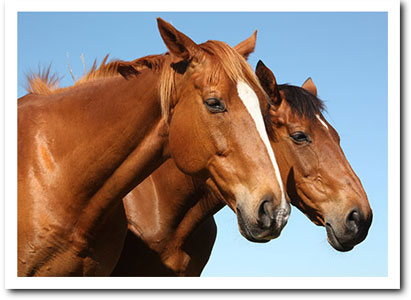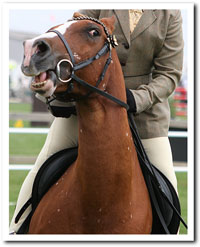Nappiness - Dull & Lethargic or Far too Impulsive
All of these problems stem from the same cause.
To the right you see two horses - Nibbler and The Phantom, both severely grass affected - The Phantom was eventually put down as he becamse a chronic Head Flicker and this was before Cathy met Jenny.
Nibbler would go from being dull and lethargic as seen here, to scarily spooky and over reactive in the space of seconds. Cathy figured they were getting enough salt and minerals from the mineral lick she supplied in the paddock - BIG MISTAKE!
The difference in Nibbler once his diet was corrected was amazing.
The Nappy Horse
Nappy is usually a term used for kid’s ponies that learn that the kicking of the child is tolerable while they get to eat grass. Or ex trekking or riding school horses who have given up being responsive and just ignore all riders.
However it can also happen to anybody, even well trained horses and describes the situation where the horse does not want to go forward. Instead the horse pins his ears, ignores or kicks out at the rider’s leg and even puts in little rears, pig roots, or swings around to go home.
Sometimes the horse may be travelling along just fine, next thing they just stop, the head goes down and they won’t budge. If you try and make them they will go backwards instead.
Sometimes the horse has the ‘half-asleep’ or ‘zonked’ look. They will be very dull to your leg and no matter how skilfully and consistently you teach them to respond it is like they never learn and are just as dull as ever.
But wow, add some salt to their diet and watch them liven up. It is unbelievable.
The Impulsive Horse
This is exactly the opposite of nappy, dull and lethargic.
An impulsive horse ridden the horse on a loose rein tends to get faster and faster. The head goes up and they seem to forget you are there. They tend to be very unbalanced and lean in on circles having to speed up to stop themselves falling over! If you ask them to yield their hind-quarters the steps are skippy and quick.
They have difficulty backing up and therefore even more difficulty stepping their front quarters around the hind. They are ‘all go and no whoa’
Some people describe it as ‘can’t put your legs on’ so they try and get around it by riding with their legs out from the horses sides. They will be inclined to pin their ears if any leg pressure is applied even when the person is trying to be light.
These horses sweat very easily, often breaking into a white, lathery sweat and they will tend to lose their top-line. They will also be busy with their mouth, chomping and grinding on the bit showing signs of agitation like tail swishing too.
 Calm Healthy Horses
Calm Healthy Horses